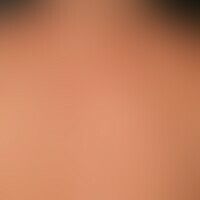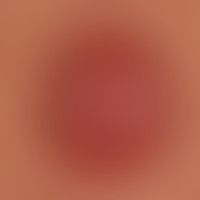Image diagnoses for "red"
901 results with 4543 images
Results forred

Pityriasis rubra pilaris (adult type) L44.0
Pityriasis rubra pilaris, erythrodermalmaximum variant of pityriasis rubra pilaris.

Pyoderma gangraenosum L88
Pyoderma gangraenosum with multiple foci: Known immunosuppressive basic disease

Collagenosis reactive perforating L87.1
Collagenosis, reactive perforating, chronically dynamic (continuous neoplasms since 1 year), 0.1-0.5 cm large, slightly itchy, rough, red, rough papules, which ulcerate centrally during growth.

Melanoma acrolentiginous C43.7 / C43.7
Acrolentiginous malignant melanoma: A brown, slowly increasing spot that has existed for years. It is said that this broad-based, ulcerated, repeatedly bleeding node has been formed for a few months. Arrows mark the non-node acrolentiginous part of the tumor. A weak pigmentation zone is encircled, which histologically also turned out to be melanoma infiltration.

Field carcinogenesis
Field carcinogenesis: reddish, painful to touch, red, slightly scaly, blurred plaque, condition after years of intensive UV-radiation.0

Angiokeratome, solitary D23.L
Angiokeratomas of the glans penis: completely symptomless blue compressible nodules with a slightly verrucous surface, therapy not necessary.

Linear porokeratosis Q82.8
Porokeratosis linearis unilateralis: For years, a site-constant linear dermatosis with non-itching, red, centrally hyperkeratotic papules and plaques.

Primary cutaneous diffuse large cell b-cell lymphoma leg type C83.3
Primary cutaneous diffuse large cell B-cell lymphoma leg type: red nodules occurringwithin a few months in an otherwise healthy 54-year-old woman.

Erythema e calore L59.0
Erythema e calore. regular applications of heat pads for chronic back problems.

Lichen planus (overview) L43.-
Exanthematic lichen planus withinfestation of the integument and oral mucosa, here: infestation of the inner thigh and vulva.

Sweet syndrome L98.2
Dermatosis, acute febrile neutrophils. following high fever on the back of a 52-year-old man, acutely occurring multiple, reddish-livid, succulent, pressure-dolent, infiltrated papules confluent to nodules and plaques. overall generalized picture with emphasis on extremities and trunk.

Unilateral naevoid telangiectasia syndrome I78.8

Stevens-johnson syndrome L51.1
Stevens-Johnson syndrome: acute, extensive, painful erosions of the red of the lips, the lip mucosa, the tongue and the gingiva in an 18-year-old woman.

Primary cutaneous (anaplastic) large cell lymphoma cd30-negative C84.5
Lymphoma cutaneous T-cell lymphoma large cell anaplastic.

Herpes simplex virus infections B00.1
Herpes simplex virus infection: Typical clinical finding of genital herpes simplex. 2 grouped vesicles on an erthematous plaque are found on the inner preputial leaf of a 40-year-old patient. Only very discreet symptoms. 2nd episode in loco.

Granuloma annulare subcutaneum L92.0

Pemphigus vulgaris L10.0
Pemphigus vulgaris. multiple, chronic, since 3 years in batches, symmetrical, trunk accentuated, easily injured, flaccid, 0.2-3.0 cm large, red blisters confluent to larger, weeping and crusty areas.







